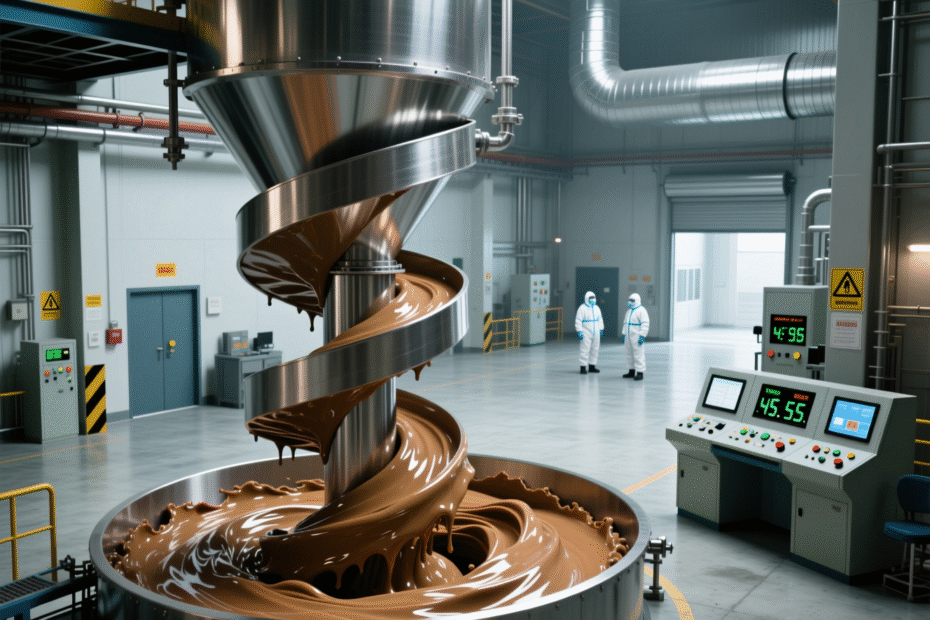Imagine standing in front of a 500-gallon mixing tank, ingredients ready, timers set, pressure mounting — and you realize… you’ve never actually mixed at this scale before. Sound familiar? Whether you’re crafting artisanal sauces, industrial adhesives, pharmaceuticals, or even large-batch cocktails for events, mastering batch mixing for large quantities isn’t just about scaling up — it’s about scaling smart.
In today’s fast-paced production environments — from food manufacturing to chemical processing — efficiency, consistency, and safety are non-negotiable. Yet, many professionals jump into large-batch mixing without fully understanding the nuances that separate a smooth, homogenous blend from a costly, lumpy disaster.
This article is your backstage pass to the world of industrial and semi-industrial mixing. We’ll break down proven techniques, common pitfalls, equipment considerations, and real-world hacks that turn chaotic batches into seamless successes.
You’ll walk away not just knowing how to mix large quantities — but why certain methods work, when to adjust your approach, and what small tweaks can save you time, money, and sanity. Whether you’re a small business scaling up or a seasoned operator looking to optimize, this guide is packed with actionable insights you won’t find in equipment manuals.
Let’s dive in — your perfect batch is waiting.
1. Understanding the Physics Behind Large-Scale Mixing: It’s Not Just Bigger, It’s Different
When you double, triple, or 10x your batch size, you’re not just multiplying ingredients — you’re entering a whole new world of fluid dynamics, heat transfer, and mechanical stress. What worked beautifully in your 5-gallon kitchen mixer might fail spectacularly in a 500-gallon industrial vessel.
Why? Because scaling isn’t linear.
In small batches, manual stirring or low-powered mixers can create enough turbulence to evenly distribute ingredients. But in large tanks, dead zones — areas where little to no mixing occurs — become a serious problem. Gravity, viscosity, and ingredient density start playing much bigger roles. A heavier ingredient might sink and never resuspend. A lighter one might float and never integrate.
Real-world example: A craft hot sauce company scaled from 10-gallon batches to 200-gallon tanks. They kept using the same paddle mixer speed and time. Result? Settled chili flakes at the bottom, inconsistent heat levels per bottle, and angry customers. Solution? They switched to a high-shear mixer with baffles and increased RPMs — problem solved.
Key takeaway: Large-scale mixing requires understanding three core principles:
- Shear force – how aggressively ingredients are broken apart and blended.
- Flow patterns – how materials circulate within the tank (axial vs. radial flow).
- Residence time – how long each particle spends in the active mixing zone.
Ignoring these? You’re ambling with quality.
Pro Tip: Before scaling up, simulate your process with water and food dye in a transparent tank. Watch how the color disperses. Where does it linger? That’s your dead zone. Adjust impeller placement or tank design before adding expensive ingredients.
2. Choosing the Right Equipment: It’s Not One-Size-Fits-All (And Why That Matters)
You wouldn’t use a butter knife to carve a turkey — so why use a planetary mixer for 1,000 lbs of dough?
Equipment selection is the make-or-break factor in large-batch mixing. But here’s the catch: there’s no universal “best” mixer. The right choice depends on your product’s viscosity, ingredient types, batch size, and desired texture.
Let’s break it down simply:
- Low-viscosity liquids (sauces, beverages, syrups): Use propeller or turbine mixers. They create strong axial flow, pushing liquids from top to bottom for quick homogenization.
- Medium-viscosity (batters, creams, gels): Go for anchor or helical ribbon mixers. These hug the tank walls and scrape the bottom, preventing buildup and ensuring even heat distribution.
- High-viscosity (doughs, pastes, putties): Planetary or double-arm mixers are your friends. They move in multiple directions, kneading and folding rather than just stirring.
Case in point: A bakery producing artisan bread scaled up to 300-lb batches. They tried using a giant version of their old spiral mixer. Dough was overworked on the edges, undermixed in the center. Switched to a double-hook planetary mixer — perfect gluten development, consistent texture, no more waste.
Don’t forget the tank design. Flat bottoms? Trouble for scraping. Rounded bottoms? Better flow. Baffles? Essential for preventing vortexing and improving top-to-bottom turnover.
Budget-friendly hack: If you can’t afford a custom industrial mixer yet, consider retrofitting. Many manufacturers offer modular upgrades — stronger motors, interchangeable blades, digital timers — that can extend the life of your current equipment while you scale.
Remember: The goal isn’t just to mix — it’s to mix efficiently. A poorly chosen mixer can double your energy costs and triple your cleanup time.
3. The Human Factor: Workflow, Timing, and Team Coordination (Because Machines Don’t Work Alone)
Here’s a truth no equipment brochure will tell you: your mixer is only as good as the team running it.
Large-batch mixing introduces logistical challenges that simply don’t exist at smaller scales. Think: ingredient staging, sequential addition, temperature control, sampling, cleaning — all while racing against the clock (and sometimes, against ingredient separation).
Common pitfall: Dumping everything in at once. Sounds efficient? It’s not. Heavy powders sink. Oils float. Enzymes activate too early. The result? Inconsistent product and wasted materials.
Solution? Staged addition.
Break your process into phases:
- Liquids first — create a vortex to pull in powders evenly.
- Powders next — sifted and added gradually to avoid clumping.
- Fats or oils last — emulsify after the base is homogenous.
- Heat-sensitive ingredients? Add post-mix, during cooling.
Real-life analogy: Think of it like cooking pasta. You don’t throw sauce, cheese, and noodles into cold water and hope for the best. You boil water first, add pasta, then sauce, then cheese — each at the right time. Same logic applies to industrial mixing.
Team coordination tip: Use color-coded ingredient bins and checklists. Assign roles: one person adds, one monitors temperature, one times the cycle. Even a 2-person team can run like a well-oiled machine with clear SOPs (Standard Operating Procedures).
Bonus: Record every batch — time, temp, RPM, additions. Over time, you’ll spot patterns. Maybe Batch #42 always separates? Check what was different that day. Data is your silent quality control manager.
4. Troubleshooting Like a Pro: Spotting (and Fixing) Problems Before They Cost You
Even with perfect equipment and a trained team, things go wrong. Ingredients vary. Temperatures fluctuate. Power surges happen. The difference between a pro and an amateur? How quickly — and calmly — you respond.
Here are the top 5 large-batch mixing issues — and how to fix them:
✅ Problem #1: Incomplete Mixing (Lumps, Layers, or Settling) → Fix: Increase RPM, add baffles, switch to high-shear impeller, or extend mixing time. Pre-mix powders with a small amount of liquid before adding to the main batch.
✅ Problem #2: Overheating (Especially with Friction-Sensitive Products) → Fix: Use cooling jackets, reduce RPM, or pulse the mixer instead of running continuously. Monitor with an infrared thermometer.
✅ Problem #3: Foaming or Air Entrapment (Ruins texture and shelf life) → Fix: Lower impeller speed, use defoaming agents (food-grade if needed), or switch to vacuum mixing for sensitive products like sauces or cosmetics.
✅ Problem #4: Ingredient Degradation (Enzymes dying, flavors fading) → Fix: Control temperature rigorously. Add heat-sensitive ingredients last. Use insulated tanks or cooling coils.
✅ Problem #5: Scaling Inconsistencies (Batch #1 perfect, Batch #2 a mess) → Fix: Standardize everything — weigh ingredients (never scoop!), calibrate timers, document ambient conditions. Use batch logs religiously.
Pro Insight: Always keep a “sacrificial small batch” on hand — 5-10% of your full recipe — to test adjustments before risking the whole tank. It’s cheaper to waste 10 lbs than 1,000.
Also — clean as you go. Residue from Batch A can contaminate Batch B. Schedule cleaning between runs, even if it “looks clean.” Microbial growth and cross-contamination don’t announce themselves.
5. The Future of Batch Mixing: Automation, AI, and Sustainable Practices
Let’s get futuristic for a moment.
Imagine a mixer that learns your recipes, adjusts RPM based on viscosity in real-time, alerts you when an ingredient is running low, and even schedules its own maintenance. Sounds sci-fi? It’s already here.
Automation is no longer a luxury — it’s a competitive edge.
- Smart sensors monitor viscosity, temperature, and pH — adjusting parameters on the fly.
- AI-driven systems predict when a batch will reach optimal homogeneity, reducing guesswork and energy waste.
- Cloud-based logs let you access batch data from anywhere — perfect for audits, troubleshooting, or remote team management.
But you don’t need a $100K system to benefit.
Start small:
- Use programmable timers and RPM controllers (many cost under $500).
- Integrate digital scales with your batching software.
- Adopt IoT temperature sensors that send alerts to your phone.
Sustainability angle: Large-batch mixing consumes serious energy. Optimizing your process isn’t just good for quality — it’s good for the planet (and your bottom line).
→ Use variable frequency drives (VFDs) to match motor speed to load. → Recover heat from cooling jackets to pre-warm incoming ingredients. → Optimize batch sizes to reduce idle time and cleaning cycles.
Storytime: A small-batch kombucha brewery in Oregon automated their 300-gallon ferments. Result? 22% less energy use, 15% faster turnaround, and — most importantly — zero batch failures in 18 months. They reinvested the savings into organic ingredients. Win-win.
The future isn’t about replacing humans — it’s about empowering them. Let machines handle the metrics. You handle the magic.
Conclusion: Your Large-Batch Mixing Journey Starts Now — And It’s Worth Every Stir
Let’s rewind.
We’ve walked through the physics that govern large-scale mixing — why bigger isn’t just “more,” but fundamentally different. We’ve explored equipment choices that can make or break your batch. We’ve emphasized the human element — because no machine runs itself. We’ve armed you with troubleshooting tactics to rescue even the messiest situations. And we’ve peeked into the future, where automation and sustainability aren’t buzzwords — they’re necessities.
But here’s the real takeaway: mastery comes from doing, not reading.
You don’t need a PhD in fluid dynamics. You don’t need a million-dollar setup. You need curiosity, attention to detail, and the willingness to learn from every batch — the perfect ones and the disasters.
So what’s your next move?
→ Revisit your current process. Where are the dead zones? Where’s the waste? → Test one new technique this week — staged addition, a new impeller, a digital timer. → Document everything. Your future self will thank you.
Large-batch mixing isn’t just a technical skill — it’s an art. And like any art, it improves with practice, patience, and passion.
Your challenge this week: Pick one batch — just one — and mix it with 10% more intention than usual. Watch the flow. Listen to the motor. Time each addition. Taste (or test) the result. Then ask yourself: What changed? What improved?
That’s how legends are made — one perfectly mixed batch at a time.
Got a mixing horror story — or a brilliant hack? Share it in the comments below! What’s the weirdest thing you’ve ever had to mix in bulk? Let’s learn from each other. And if you found this guide helpful, share it with a colleague who’s staring nervously at a giant mixing tank right now. They’ll thank you.

Thayná Alves is an influential digital content creator who has carved out a significant space in the realms of technology, finance, and entrepreneurship. Through her blog, Newbacker.com , she stands out as an authentic and accessible voice for individuals seeking practical information about investments, innovation, and emerging trends in the financial market.
